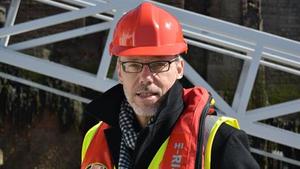DONG Energy: New crew transfer vessel helps reduce Cost of Electricity
Operations and maintenance (O&M) on offshore wind turbines typically accounts for approx. 20% of the total investment in an offshore wind project. One of the reasons being that the availability of the turbines is frequently challenged by tough weather conditions, making it difficult to quickly reach the turbines by boat.
This is about to change at the Borkum Riffgrund 1 Offshore Wind Farm in the North Sea. As of 1 March 2015, we've chartered a new crew transfer vessel, which – using newly developed air cushion technology – allows us to reach wind turbines at greater speed, in tougher weather conditions and with greater comfort for our O&M personnel. Naval Architect and Lead Maritime Project Manager, Niels Agner Jensen, said:
"The new Wave Craft vessel has the potential of significantly optimising our operations and maintenance of offshore wind farms and thereby reduce Cost of Electricity. Not only will our wind turbine availability increase, because the vessel is more stable and less susceptible to hard weather. We'll also become more efficient, as the speed of the vessel allows us to reach the turbines much faster than before. This means that we can reduce the amount of time spent on transportation as well as the idle time of our O&M team."

Naval Architect and Lead Maritime Project Manager, Niels Agner Jensen.
Marc Costa-Ros, Manager Innovation at the Carbon Trust commented: “The WaveCraft is one of the finalist crew transfer vessels innovations that have been de-risked throughout the Offshore Wind Accelerator. We see the sea trials as a culmination of the commercialisation of a very promising vessel, as well as a very important input to assess its performance by collecting rough data and validating the vessel capabilities.”
Carbon Trust’s OWA will be responsible of collecting the vessel performance data during the trial period and analysing it.
Stable crew transfers
The Wave Craft vessel's innovative design is adapted from vessels used by the Royal Norwegian Navy. It's a so-called ‘Surface Effect Ship’ which uses an air-cushion to achieve extremely fast speeds to reach wind turbines faster and thereby utilise shorter 'weather windows' than by using conventional crew transfer ves-sels (CTVs). In addition, most of the vessel's weight is lifted by the air cushion, which helps to stabilise it for transferring crew on and off the turbine.
"While the vessel is extremely fast, the air cushion still allows for a safer and more stable transfer of O&M personnel, both when onboarding and leaving our offshore wind turbines. Greater comfort also helps to reduce the risk of motion sickness, which means that the O&M personnel will arrive in a more comfortable way at the wind turbines, leaving more time for their work," said Niels Agner Jensen.
High expectations
The development of the two crew transfer vessels has been supported both financially and technically by the UK Carbon Trust Offshore Wind Accelerator programme, of which DONG Energy is one of nine industry partners. Jørn Scharling Holm, Technology Partnership Manager in Wind Power, said:
"This is a very tangible example of how the Carbon Trust OWA programme partners have worked together to bring down the costs of offshore wind through innovation. We're looking very much forward to testing the new vessels at Borkum Riffgrund 1, and we have high hopes that they prove themselves as fast, comfortable and robust as we believe they are."
The vessel will be trialled using special equipment to log and monitor its performance to enable a compari-son with the other vessels operating on Borkum Riffgrund 1 Offshore Wind Farm.
- Source:
- DONG Energy
- Link:
- www.dongenergy.com/...